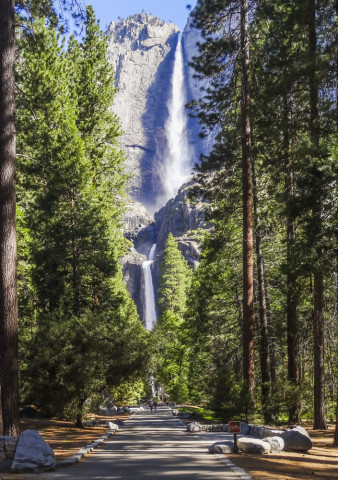
One of the world’s tallest waterfalls, this wonder impresses even within a national park known for its natural beauty. It’s composed of three separate falls: Upper Yosemite Fall, the middle cascades and Lower Yosemite Fall.
13 Waterfalls You Need in Your Life:
No Passport Required
1. Yosemite Falls, Yosemite Village, California

One of the world’s tallest waterfalls, this wonder impresses even within a
national park known for its natural beauty. It’s composed of three separate
falls: Upper Yosemite Fall, the middle cascades and Lower Yosemite Fall.
How to see it:
The falls are visible from
Yosemite Valley, but can
also be accessed up-close via a six-to eight-hour roundtrip
hiking trail. Reserved
for more experienced adventurers, the difficult hike covers 7.2 miles and gains
2,700 feet of elevation — but those who do choose to take this route are
rewarded with stunning views from the top of the waterfall.
Travelzoo Tip:
Peak flow is in May, so visitors during this time have the
best chance of catching the falls in action.
2. Multnomah Falls, Bridal Veil, Oregon
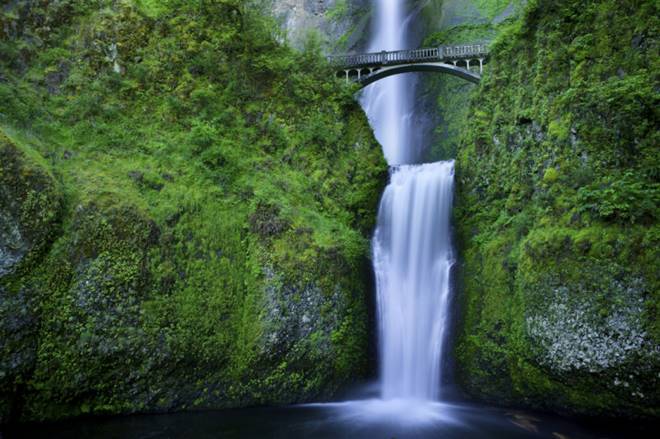
Undeniably one of the most famous waterfalls in the U.S., Multnomah Falls
embodies the best the Pacific Northwest. Running between two large green
mountains and underneath the Benson walking bridge, the picturesque location
seems straight out of a storybook — and tailor made for an Instagram snapshot.
How to see it:
The
Multnomah Falls
designated viewing area is easily accessible from the road, and is supplemented
by a visitors center and the
Multnomah Falls Lodge.
Guests who come prepared to brave the weather can hike along the 1.2-mile trail
to the top of the falls, including crossing over Benson Bridge. Though it’s a
relatively short route, it comprising of many switchbacks and difficult (read:
often muddy) terrain.
Travelzoo Tip:
Triple down on your waterfall viewing by also checking out
Latourell Falls and Bridal Veil Falls, two less touristy and thus less crowded
nearby landmarks. Bridal Veil Falls is just 3.6 miles from Multnomah, and
Latourell Falls is another 2.3 miles from there — all under a 15-minute drive
from each other in total.
3. Havasupai Falls, Grand Canyon, Arizona
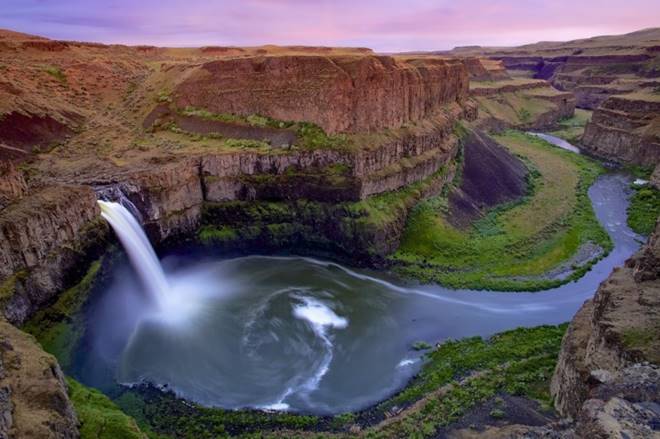
Waterfalls don’t get much beautiful than Havasupai Falls, located in the Arizona
region of the Grand Canyon. The juxtaposition of the red rock formations and the
vibrant teal water makes this a popular destination for hikers, tourists, and
virtually anyone who can appreciate a stunning slice of natural beauty. The
falls are named for the Havasupai people, native to the Grand Canyon.
How to see it:
Unlike many others on this list,
Havasupai Falls is
unfortunately not accessible from the road. It’s a 10-mile hike to the falls,
and visitors have two options: either make a reservation independently, or buy
into a guided tour.
Travelzoo Tip:
Reservations are often booked out months in advance, so
your best bet to check out the falls may be through one of the tour companies
that have consistent access.
4. Vernal Fall, Yosemite National Park, California
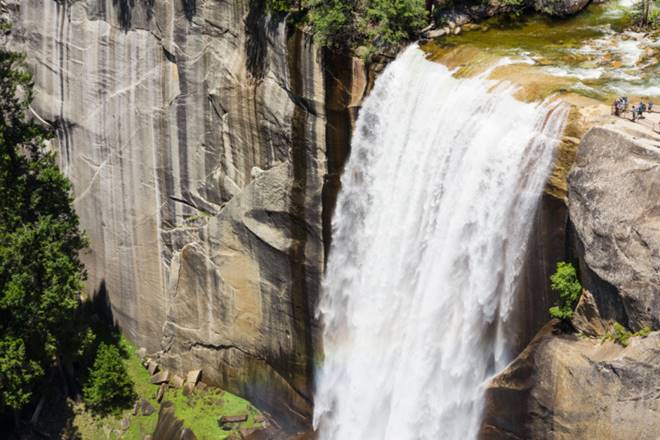
This 317-foot fall is on the Merced River and runs yearlong, though is weakest
at the end of summer and most spectacular during spring. As its situated within
Yosemite National Park, the fall is surrounded by a host of other natural sites
ripe for visiting before/ after you visit Vernal.
How to see it:
Vernal Fall is is
accessible via a 3-mile roundtrip hike along the historic Mist Trail, Yosemite’s
signature hike. Visitors often note that the trail itself is almost as
breathtaking as the falls. The trail includes a series of stairs — especially to
the top of Vernal — and is strenuous.
Travelzoo Tip:
You’ll likely get wet from the waterfall mist —
though how dry you stay often depends on how close you get to (or how far you
stay from) the stream. If you’re not into the idea of getting wet you may want
to wear some waterproof clothing.
5. Shoshone Falls, Twin Falls, Idaho
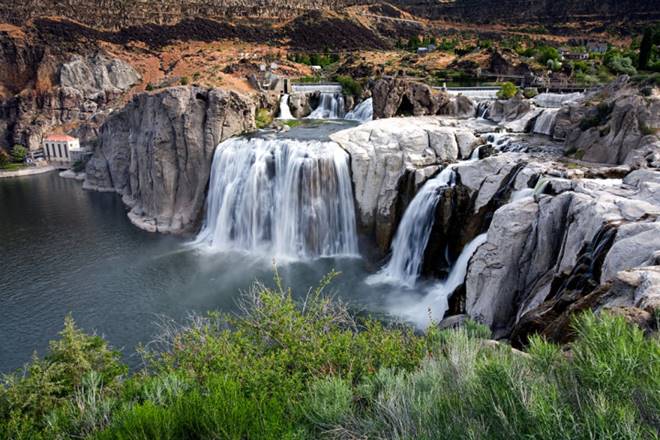
At one end of Twin Falls, Shoshone Falls draw a natural comparison to Niagara
(often called the Niagara of the West) — and are, in fact, even higher. The
falls are wide and composed of a variety of individual falls. The natural beauty
is magnified by the backdrop of blue skies and majestic mountains.
How to see it:
Accessible via car,
Shoshone Falls is ideal
for families, or those who aren’t interested in hiking. The full visitor space
features recreational areas including playgrounds, hiking trails, grassy areas,
boat ramps, a swimming area and scenic overlook.
Travelzoo Tip:
Bring a picnic to enjoy on one of the lawns that offer
views of the Shoshone Falls.
6. Alamere Falls, Bolinas, California
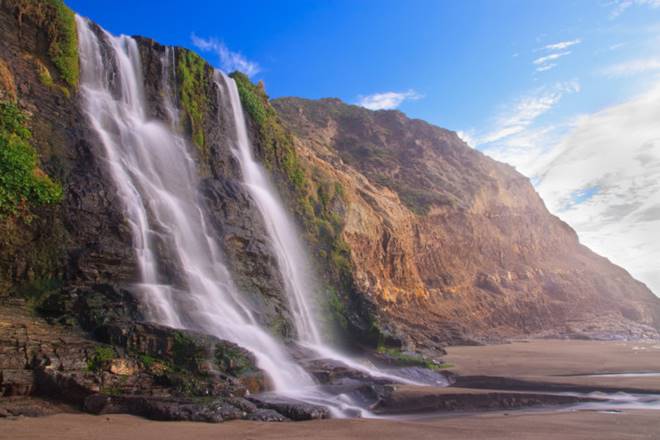
Located along the Point Reyes National Seashore within Marin County, Alamere
Falls is a tidefall — meaning it runs directly into the ocean. Breathtakingly
beautiful, the falls are accessible year-round, but are at their best after
winter and spring rainfall.
How to see it:
After parking at the Palomarin trailhead, you’ll hike along the Crest Trail to
Wildcat Camp, then south down to the beach. The full trip to
Alamere Falls is a
13-mile roundtrip hike, so many visitors opt to make it a weekend and stay at
Wildcat Camp overnight. Though the trail is long, it offers stunning views of
the ocean, lakes and vegetation.
Travelzoo Tip:
If you’re visiting during warm months, take a dip in the
nearby Bass Lake.
7. Ruby Falls, Chattanooga, Tennessee
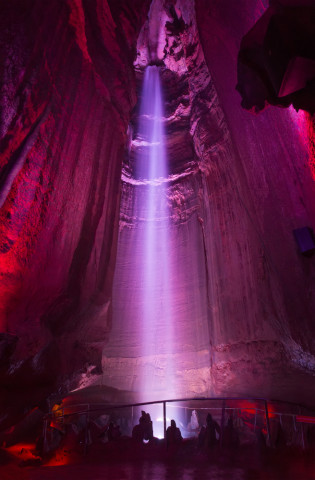
Uniquely tucked underground within a cave, America’s deepest commercial cave and
largest underground waterfall are a popular tourist attraction in Tennessee.
How to see it:
The
Ruby
Falls attraction area offers tours of the cave
and falls, and features an additional range of activities for tourists of all
ages like a ZIPstream Aerial Adventure park and Fun Forest Playground.
Travelzoo Tip:
For the brave, Ruby Falls offers
lantern tours on Friday
nights, where small tours are led to the falls guided by a lantern-lit path.
8. Triple Falls, Cascade Locks, Oregon
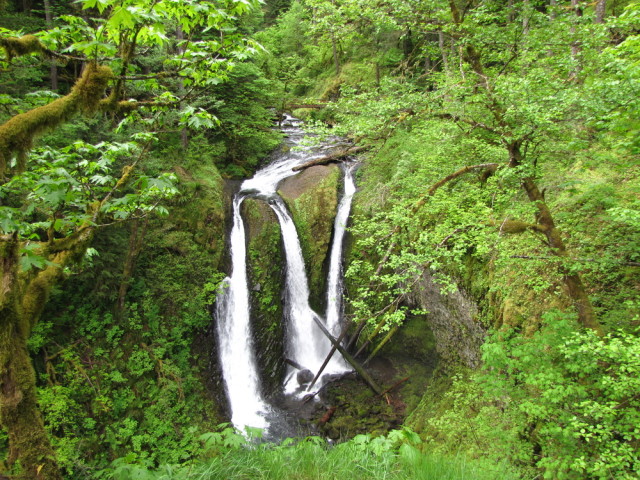
Aptly named, Triple Falls features what appears to be three separate streams,
all of which flow from and to the Oneonta Creek. Surrounded by lush greenery
along the Columbia River Gorge, it’s a breathtaking hike-in waterfall known for
its serenity and natural setting.
How to see it:
The falls are accessible via a 5-mile out-and-back section of the Oneonta Trail.
Hikers traverse switchbacks and can check out other falls, including the Middle
Oneonta Falls, along the way. The hike is rated at a moderate difficulty, but
does include a section of rocky scrambles to reach the falls itself.
Travelzoo Tip:
Be aware that the
trail does have some
steep dropoffs.
9. Palouse Falls, Lacrosse, Washington

The star of the Palouse Falls State Park, the iconic waterfall serves as a
centerpiece for the park’s trails, attractions and activities. The falls has two
sections — upper and lower — and lies on the Palouse River.
How to see it:
The
Palouse Falls State Park
offers a variety of trails with views of the waterfall, all of which are easy to
moderately rated and dog (leashed) and child-friendly.
Travelzoo tip:
The park also offers 105 acres of camping, featuring 11 tent spaces — so make it
an overnight trip!
10. Arethusa Falls, Hart’s Location, New Hampshire

Located in the White Mountains of New Hampshire, Arethusa Falls is most
noteworthy because of the way the water cascades over the layers of natural
granite.
How to see it:
The waterfall is accessible via the
Arethusa Falls Trail, a
2.6-mile round-trip hike from a well-marked parking lot off the main road. The
trail leads to the base of the falls.
Travelzoo Tip:
From the parking lot, visitors can also embark on the trail toward Bemis Brook,
which features the Fawn Pool, Coliseum Falls and Bemis Brook Falls.
11. Manawaiopuna Falls, Hanapepe, Kauai
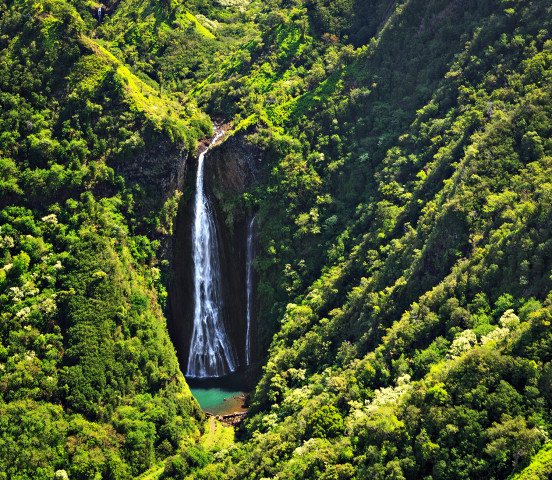
Best known for its appearance in Jurassic
Park, this waterfall is often nicknamed “Jurassic
Falls.” The falls are privately owned, and thus are only accessible via
helicopter tours… not that we’re complaining about the view from the top.
How to see it:
The helicopter adventures offer visitors a chance to both check out the sights
from the air, as well as to land at the base of the falls and explore the
400-foot waters firsthand.
Travelzoo tip:
The helicopter tours aren’t cheap, but rave customer reviews prove that the
journey — aka a helicopter ride over Kauai — is just as memorable as the
destination.
12. Sliding Rock, Pisgah Forest, North Carolina
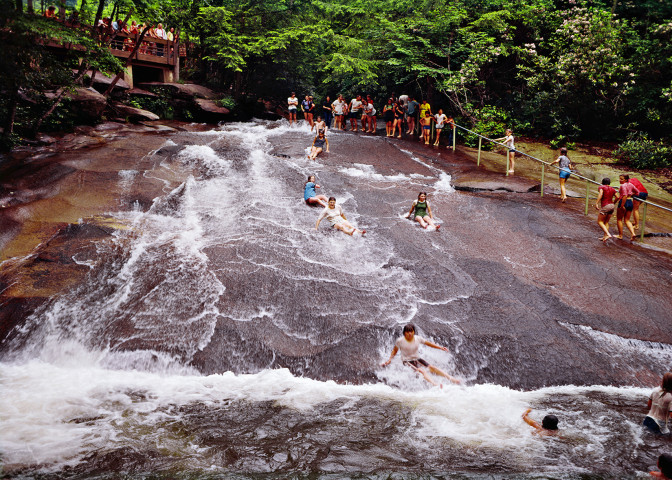
Sliding Rock is one of the most unique (and fun) waterfalls in the world — and,
lucky for us, it’s located right here in North Carolina. A natural water slide
on which visitors can slide down and into a plunge pool at the bottom, the
family-friendly landmark offers an interactive adventure that will make you feel
like Tarzan.
How to see it:
Located in the Pisgah Forest, Sliding Rock is outside of Brevard. The fall is
located within its own recreation area, which includes parking, restrooms and
changing rooms.
Travelzoo Tip:
If you’re traveling with children, your safest bet is to
visit during summer weekends, when there is often a lifeguard on duty. Though
children below a certain height must slide on an adult’s lap, the gentle incline
makes this a fun and safe activity for the little ones.
13. Seven Falls, Colorado Springs, Colorado
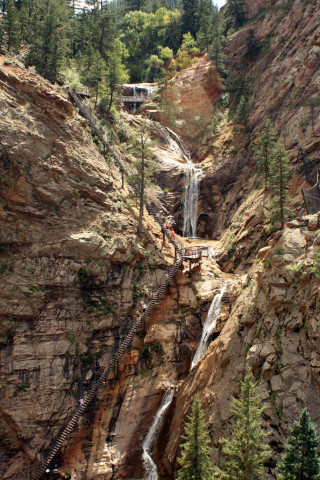
Aptly named, Seven Falls consists of seven cascading
waterfalls in South Cheyenne Cañon: Bridal Veil, Feather, Hill, Hull, Ramona,
Shorty and Weimer. The area around Seven Falls was reopened last year after
renovations that helped the falls recover from flooding and transform into a
tourist destination. The reopened space features free parking, the Broadmoor
Hotel, a fine dining restaurant and a zip line.
How to see it:
A series for 224 steps runs alongside the stream, and offer visitors of all ages
a safe way to see the landmark up close and reach the lookouts along the trail
and at the top of the falls. For those not able or feeling up for the many
steps, an in-mountain elevator brings guests to the “Eagles Nest” viewing
platform, 185 steps up.
Travelzoo tip:
For those wishing to hike even farther — and to see some of
the best views of Colorado Springs available — trails to Inspiration Point and
to Midnight Falls begin at the top of Seven Falls.